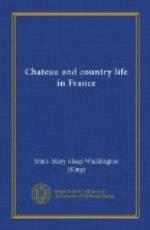[10] “Le Grand Arnauld” (Antoine), one of the first and most influential of the celebrated “Solitaires” who established themselves at Port Royal, and one of the founders of the famous sect of Jansenists whose controversies with the Jesuits convulsed the whole religious world in France during the years 1662-1668. He was followed in his retreat by his mother (after the husband’s death), his brother and four sisters, one of whom became the “Mere Angelique,” Abbesse of Port Royal.
He returned many times to La Ferte-Milon, and the great poet and private historian of the Roi Soleil must often have climbed the steep little street that leads to the ruins, and thought of the changes, since the little boy lay on the grass at the foot of the great walls, dreaming golden dreams of the future, which for him were so brilliantly realised.
In a small country town one is slow to adopt new ideas, slower still to carry them out, but the Mayor and cure were both most anxious to do something in the birthplace of the poet, and that was the general feeling in the Department. After many discussions we finally arrived at a solution, or at least we decided what we wanted: a special service in the fine old church of Notre Dame, which stands beautifully on the hill, close to the ruins; a representation of the Comedie Francaise, and of course a banquet at the Sauvage, with all the official world, senators, Prefet, Academiciens—a band of music, a torch-light procession, and as many distinguished visitors as we could get hold of. Funds of course were a necessary item, but all the countryside contributed largely, and we knew that the artists would give their services gratis.
We arranged a breakfast at my house in Paris with Mons. Casimir-Perier, late President of the Republic, who was always ready to lend his influence for anything that interests the people, and teaches them something of their great men, and Mons. Claretie, Directeur of the Comedie Francaise, a most cultivated, charming man. He is generally rather chary of letting his pensionnaires play en province, but this really was an occasion to break through his rules, and he was quite ready to help us in every way. We had also M. Sebline, Senator of the Aisne, and l’Abbe Marechal, cure of La Ferte-Milon. We had wanted one of the Administrateurs of the Chemin de Fer du Nord to arrange about a free transport for the actors, but there seemed some trouble about getting hold of the right man, and Sebline promised to see about that.




